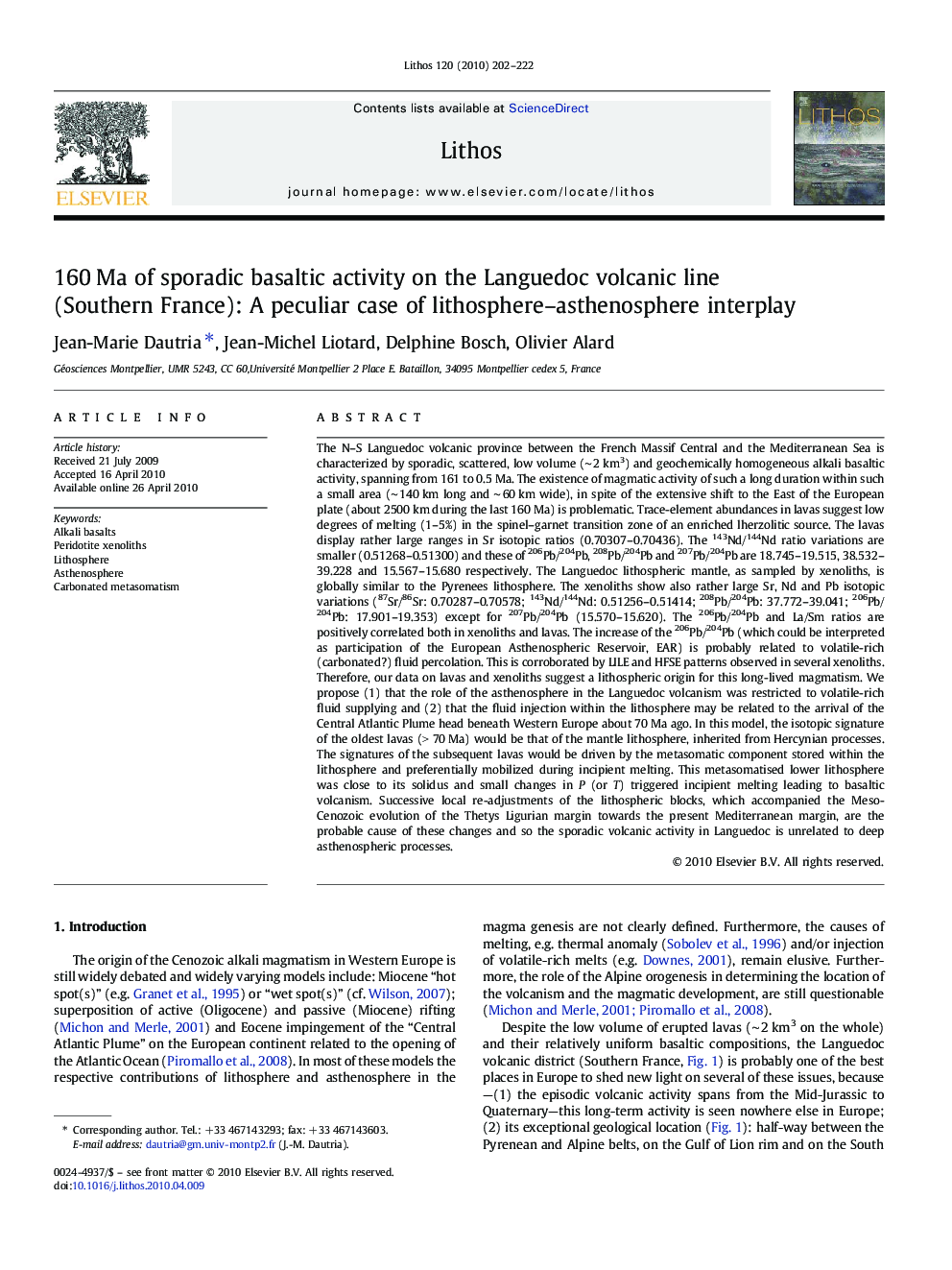| کد مقاله | کد نشریه | سال انتشار | مقاله انگلیسی | نسخه تمام متن |
|---|---|---|---|---|
| 4716820 | 1638727 | 2010 | 21 صفحه PDF | دانلود رایگان |

The N–S Languedoc volcanic province between the French Massif Central and the Mediterranean Sea is characterized by sporadic, scattered, low volume (∼ 2 km3) and geochemically homogeneous alkali basaltic activity, spanning from 161 to 0.5 Ma. The existence of magmatic activity of such a long duration within such a small area (∼ 140 km long and ∼ 60 km wide), in spite of the extensive shift to the East of the European plate (about 2500 km during the last 160 Ma) is problematic. Trace-element abundances in lavas suggest low degrees of melting (1–5%) in the spinel–garnet transition zone of an enriched lherzolitic source. The lavas display rather large ranges in Sr isotopic ratios (0.70307–0.70436). The 143Nd/144Nd ratio variations are smaller (0.51268–0.51300) and these of 206Pb/204Pb, 208Pb/204Pb and 207Pb/204Pb are 18.745–19.515, 38.532–39.228 and 15.567–15.680 respectively. The Languedoc lithospheric mantle, as sampled by xenoliths, is globally similar to the Pyrenees lithosphere. The xenoliths show also rather large Sr, Nd and Pb isotopic variations (87Sr/86Sr: 0.70287–0.70578; 143Nd/144Nd: 0.51256–0.51414; 208Pb/204Pb: 37.772–39.041; 206Pb/204Pb: 17.901–19.353) except for 207Pb/204Pb (15.570–15.620). The 206Pb/204Pb and La/Sm ratios are positively correlated both in xenoliths and lavas. The increase of the 206Pb/204Pb (which could be interpreted as participation of the European Asthenospheric Reservoir, EAR) is probably related to volatile-rich (carbonated?) fluid percolation. This is corroborated by LILE and HFSE patterns observed in several xenoliths. Therefore, our data on lavas and xenoliths suggest a lithospheric origin for this long-lived magmatism. We propose (1) that the role of the asthenosphere in the Languedoc volcanism was restricted to volatile-rich fluid supplying and (2) that the fluid injection within the lithosphere may be related to the arrival of the Central Atlantic Plume head beneath Western Europe about 70 Ma ago. In this model, the isotopic signature of the oldest lavas (> 70 Ma) would be that of the mantle lithosphere, inherited from Hercynian processes. The signatures of the subsequent lavas would be driven by the metasomatic component stored within the lithosphere and preferentially mobilized during incipient melting. This metasomatised lower lithosphere was close to its solidus and small changes in P (or T) triggered incipient melting leading to basaltic volcanism. Successive local re-adjustments of the lithospheric blocks, which accompanied the Meso-Cenozoic evolution of the Thetys Ligurian margin towards the present Mediterranean margin, are the probable cause of these changes and so the sporadic volcanic activity in Languedoc is unrelated to deep asthenospheric processes.
Journal: Lithos - Volume 120, Issues 1–2, November 2010, Pages 202–222